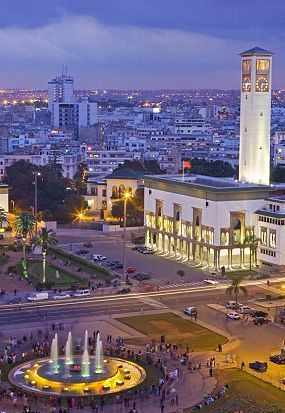When people think of Morocco, the mind often jumps to the chaos of Marrakech, the blue streets of Chefchaouen, or the dunes of the Sahara. But Casablanca, the country’s largest city and economic heartbeat, offers a different flavor of Moroccan life—urban, stylish, and unapologetically modern.
Often overlooked by travelers rushing off to more “exotic” destinations, Casablanca deserves more than just a passing glance. Here’s why.
More Than a Movie
Let’s get this out of the way: the classic 1942 film “Casablanca” wasn’t actually filmed here. But the spirit of the movie still lingers. There’s a sense of old-world glamour hiding in the corners of this bustling metropolis—if you know where to look.
You can even visit Rick’s Café, a lovingly recreated version of the fictional bar from the movie, complete with live jazz, white-jacketed waiters, and vintage elegance. It’s a bit touristy, sure—but undeniably charming.
The Beating Heart: Hassan II Mosque
Casablanca is home to one of the most jaw-dropping religious monuments in the world—the Hassan II Mosque.
- It’s the largest mosque in Africa and 7th largest in the world.
- The minaret soars 210 meters (689 feet) into the sky.
- It sits partly on land and partly over the Atlantic Ocean.
- Non-Muslims are allowed to enter on guided tours—rare in Morocco.
Inside, you’ll find intricate zellige tilework, marble columns, hand-carved ceilings, and a retractable roof. It’s not just a mosque; it’s a masterpiece.
Art Deco & Architecture
Casablanca offers a fascinating mix of French colonial architecture, traditional Moroccan design, and modern high-rises. The city’s Art Deco legacy is visible in the faded elegance of buildings along Boulevard Mohammed V. If you love urban exploration and architectural photography, you’ll find gold here.
For a more upscale experience, stroll through the Maarif and Anfa neighborhoods, where Casablanca’s wealthy residents live in palm-lined streets filled with boutiques and cafés.
The Atlantic Coast Vibe
Unlike the dusty inland cities, Casablanca is a city by the sea—and the Atlantic plays a big role in local life.
- Walk the Corniche, a coastal promenade dotted with beach clubs, cafés, and ocean-view restaurants.
- Visit Ain Diab Beach for a quick dip or sunset drink.
- Dine at seaside spots like Le Cabestan, a chic restaurant perched over the waves, known for its seafood and stylish vibe.
A Taste of Urban Morocco
Casablanca’s culinary scene reflects its cosmopolitan character. You’ll find everything from classic Moroccan tagines to sushi, Lebanese, French, and contemporary fusion.
Local favorites include:
- La Sqala – A charming garden café built into an old fortress, serving traditional Moroccan cuisine.
- Bocadillos and brochettes from street vendors near the port.
- Pâtisseries – French influence lives on in the form of flaky croissants and delicate mille-feuille.
And don’t forget the coffee culture. Casablanca has a thriving café scene, where locals spend hours chatting, people-watching, or closing business deals over espresso.
Culture & Daily Life
Casablanca isn’t a tourist showpiece—it’s a working city. That’s part of its charm. You’ll see:
- Locals rushing to offices in suits and heels.
- Street vendors selling everything from olives to phone chargers.
- Kids playing soccer in dusty lots.
- Tramways zipping through traffic-choked streets.
It’s chaotic, real, and alive.
Day Trips from Casablanca
While Casablanca has enough to fill a few days, it’s also a great base for exploring:
- Rabat – The capital city, just an hour away by train, full of history and modern art.
- El Jadida – A quiet coastal town with a Portuguese fortress and relaxed vibe.
- Azemmour – An underrated riverside town with murals and a sleepy medina.
Know Before You Go
- Language: Moroccan Arabic (Darija) is widely spoken, but French is commonly used, especially in business. English is catching on.
- Best Time to Visit: Spring (April-May) and Fall (September-October) offer the best weather.
- Currency: Moroccan Dirham (MAD)
- Getting Around: The Casablanca Tramway is clean and efficient. Taxis are everywhere, but agree on the price or ask for the meter.





